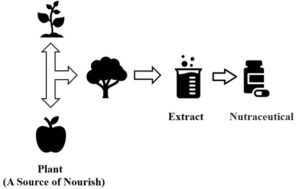Home » Innovations in Nutraceutical: Current Practices, Potential Applications and Emerging Tendencies

The word “nutraceutical” comes from “nutrition” and “pharmaceutical.” The term “nutraceuticals” refers to bioactive chemicals and food ingredients that have both high nutritive value and important physiological functions, which in turn have a beneficial impact on the health of humans [Figure 1]. Numerous popular nutraceuticals, such as vitamins, active peptides, flavonoids, and dietary fibers, have been shown to possess a variety of biological activities, such as antioxidant, antibacterial, anti-inflammatory, and anti-aging properties. Increasing one’s consumption of bioactive chemicals is increasingly accomplished through modern practices that involve the addition of nutraceuticals to functional foods.

Fig. 1: Process of Nutraceutical
Despite this, the production and use of nutraceuticals are limited due to the inherent physicochemical features of these substances as well as the myriad of environmental conditions. It is currently the most frequent solution to develop encapsulated delivery systems by using natural polymers with excellent biocompatibility (for example, proteins and polysaccharides), which can limit the influence of external influences. Encapsulated delivery systems are constructed by utilizing natural polymers with good biocompatibility (for example, proteins and polysaccharides).
In general, nutraceuticals are food components that affect and maintain human physiological function. Modern demographic and health trends are expanding the global nutraceutical business. Nutritional medical therapy is the first step to correct control of mensuration difficulties.
It is an effective approach that the starch-based carrier, which possesses excellent functional properties including crosslinking, amphipathy, and resistant digestibility, is utilized in a variety of starch-based delivery systems. These primary problems include poor water solubility, thermal instability, and low bioaccessibility of the nutraceuticals in the delivery system. Structures of amylose inclusion complex, cyclodextrin, porous starch, and microparticles are examples of some of the most common types of delivery systems used today.
Expectations for the Future:
As was just noted, there has been some encouraging study on potential applications for the starch-based delivery system in a variety of disciplines, including those of functional foods, agricultural commodities, nutritional supplements, food packaging materials, and so on. Despite this, there are still a few problems and difficulties that need to be addressed. For example, considering that the development of prebiotics food systems is hampered by the low bioavailability of nutraceuticals in the colon target delivery system, developing the appropriate starch matrix in order to improve it may be an efficient solution.
Mr. Somesh Shukla (Assistant Professor)
Lingaya’s Vidyapeeth, Nachauli, Faridabad-121002
June 6, 2023RECENT POSTS
CATEGORIES
TAGS
Agriculture Agriculture future AI Architecture artificial intelligence BA English BA Psychology BTech Engineering Business management career Career-Specific Education career guide Career Opportunities career option career scope Civil engineering commerce and management Computer Science Computer science engineering Data science degree education Engineering engineering college Engineering students English Literature english program Exam tips Fashion Design Fashion design course Higher Education Journalism journalism and mass communication law Law career Machine Learning MA Psychology Master degree mathematics MBA Mechanical Engineering Pharmacy Psychology Research and Development students
University Address: Nachauli, Jasana Road, Faridabad, Haryana
Toll Free: 1800-120-4613
Mobile : 8447744303 | 8447744304 | 8447744306 | 8447744309
Address: C-72, Second Floor, Shivalik, Near Malviya Nagar,
Above HDFC Bank, New Delhi 110017
Ph.No. - 011-46570515 / 45138169 / 41755703 / +91-7303152412
Jagmani Kutir, Ground Floor, Road No-1, Rajeev Nagar,
Near Darbar Marriage Hall, Patna-800024, Bihar
Contact No: 9818352069/8130120095
Mail: [email protected]
Copyrights © 1998 - 2025 Lingaya's Vidyapeeth (Deemed To Be University). All rights reserved.
It is important to note that the following email IDs and domains are fraudulent and do not belong to our university.
LV only conducts physical/online verification of any document related to examination on the following email id: